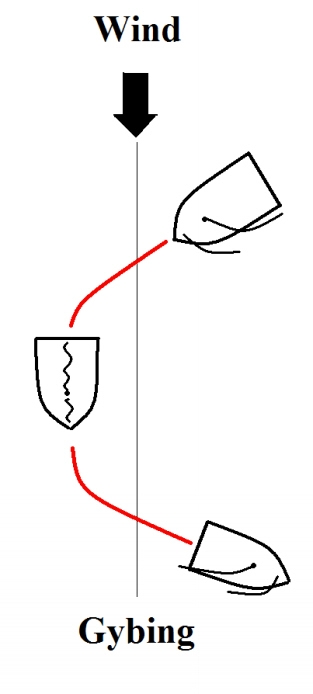How to Gybe a Sailboat
Gybing a sailboat means turning the stern (back) of the boat up through the wind (remember tacking is turning the bow of the boat up through the wind). You mus learn how to gybe if you want to sail downwind efficiently.
Looking at the diagram below, our sailboat is initially on a starboard tack (wind hitting the starboard side of the boat first).
When the helmsman (person steering the boat) wants to gybe, he will call out to his crew “Ready to Gybe”. This signals the crew to ready the sheets (lines that control the mainsail and the jib).

When the crew has readied (prepared) the sheets the crew will yell, “Ready”.
The helmsman will then say, “Gybe Ho” or “Gybing” to notify the crew that he has started to make the turn down through the wind.
It is important that the helmsman make a slow turn down through the wind so that the crew has ample time to control the sails, specifically the mainsail and the swing of the boom.
As the bow of the sailboat heads more downwind, the headsail (jib, genoa) will just start to relax. This is an excellent indicator that the boat is near the midway point of the gybe. It is important therefore, that the mainsheet be trimmed to bring the mainsail over the centerline (middle) of the boat. In other words, you must control the boom so that it does not swing violently across the deck.
The helmsman will say “centering the boom” and the mainsheet is trimmed.
When the boom has been centered the helmsman will continue making a gentle turn down through the wind. It is important to have the mainsheet at the ready so that the mainsail can be allowed to swing out from the boat gently as the sail catches wind on the new tack. Having a cleated mainsheet as the gybe is completed is not a good practice as the mainsail will fill suddenly causing the boat to heel. It is a quick matter to ease the mainsheet to level the boat with the mainsheet is not cleated. This is especially true on small sail boats where a ‘sloppy’ gybe can easily lead to capsizing.
Other crew members will be working the headsail (jib/genoa). As the boat turns more downwind, the headsail will begin to relax along the front edge of the sail. This indicates that the boat is near the mid-point of the turn where the mainsail will what to pass over the center line of the boat.
It is a common mistake to cast off the windward jib sheet too early. This will cause the jib to blow forward and wrap around the forestay. Wait until the jib is starting to back – then release the windward jib sheet. At this point the jib will easily blow across the foredeck onto the new tack.
If you are sailing solo or if you have only one crew member aboard, then for the inexperienced sailor it will be difficult to work both the mainsail and the foresail at the same time during a gybe. It is important therefore to focus primarily on the mainsail. A luffing jib poses no threat but a mainsail and boom whipping across the deck taking out shrouds and possibly snapping the mast is potentially life threatening.
Once you have controlled the swing of the boom and secured the mainsail to the new tack then switch your attention to the headsail.
It is okay to let the headsail back on itself. When you are ready, release the windward sheet and let the headsail blow across the foredeck controlling the sail with the leeward sheet.